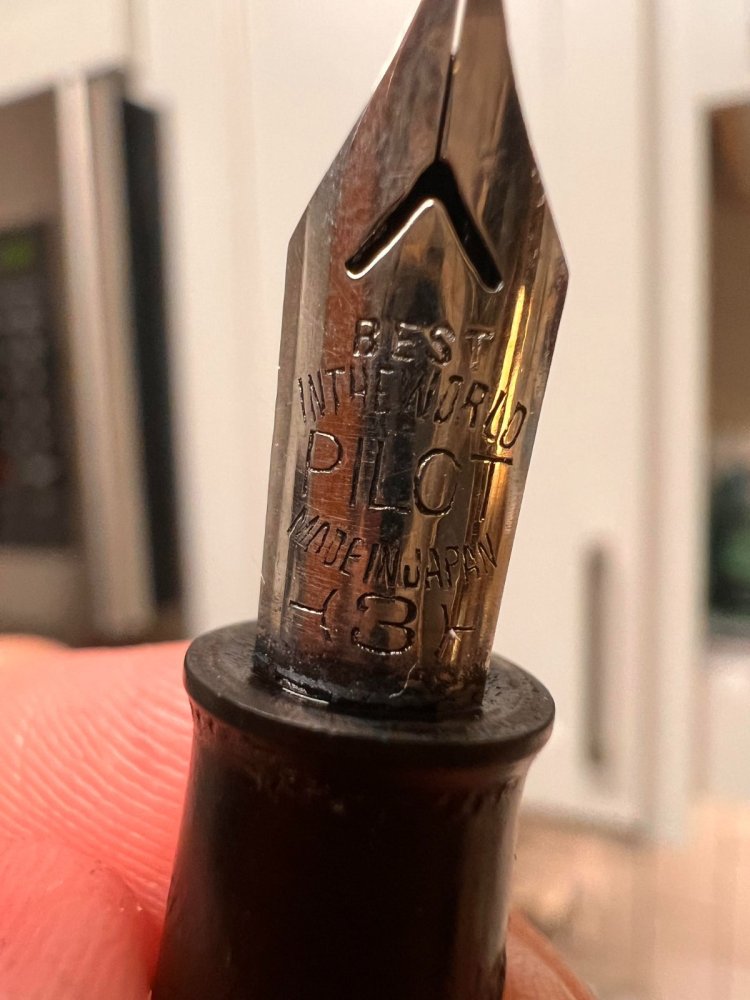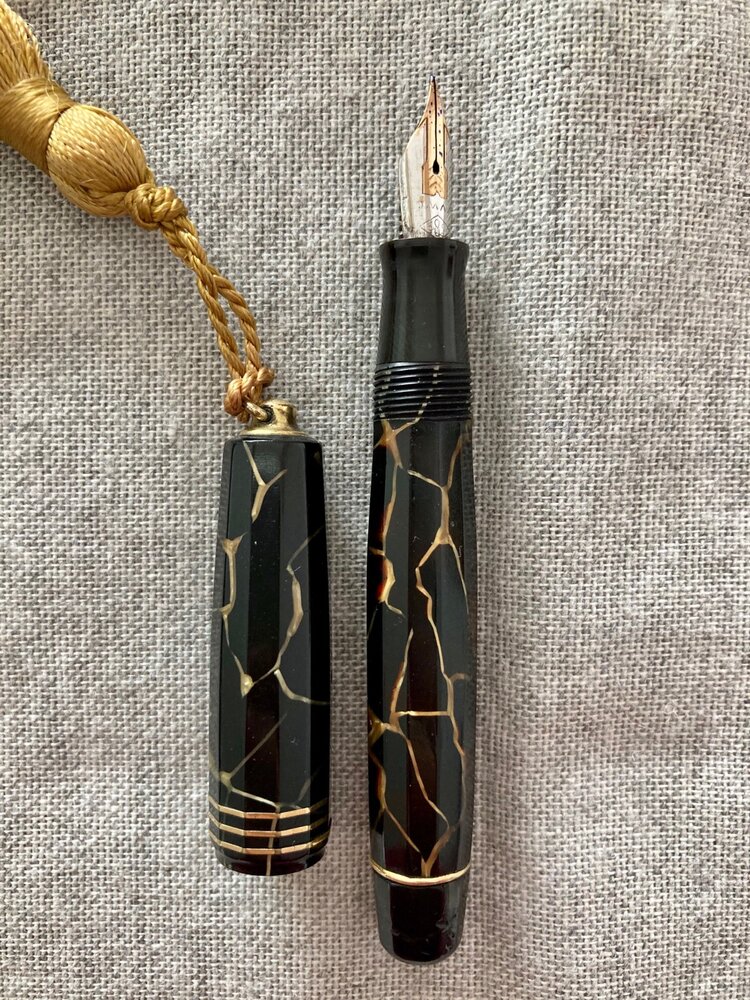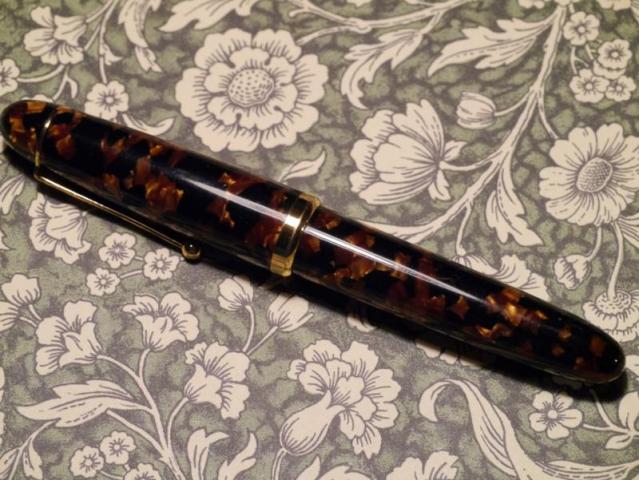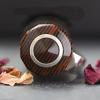Search the Community
Showing results for tags 'celluloid'.
-
When I checked my Junk Mail folder just now, I saw Bunbougu.com.au is having an End of Financial Year sale. Funny what Outlook decides to toss aside as junk mail, when I'm a repeat customer of Bunbougu (who only hit it when good discounts are on offer). (You don't need me to give you the applicable discount codes, when they're posted on the site's home page.) I had a quick note, and while there aren't really good offers for ink and fountain pen friendly paper products that I could spot at a glance, these caught my eye: the discontinued Pilot Petit1 fountain pens — even though the discounted price is still significantly higher than the product's retail price in the Japanese domestic market, back when it was easily available, for now it's lower than any price you'd see on AliExpress for such, once shipping from China (and tax, if applicable) is taken into account I think there are 17 units left in stock, across three colours, in total Sailor Shikiori Amaoto, or ‘Sound of Rain’, in the darker of two greens is discounted to half-price, making it competitive with the (fluctuating, and sometimes here-today-gone-tomorrow) lowest discounted price for it I've seen on Amazon.com.au Platinum #3776 Celluloid ‘Koi’ is half-priced, making the offer competitive with the lowest offer for it I've seen on Amazon.com.au in the past three years two units with F nibs remain — although it's the only #3776 Celluloid variant I don't yet have, and the discounted price is much cheaper now than its current retail price in the Japanese domestic market, I didn't pick one up the Pilot Capless in matt blue, with a choice of F or M nib, is decently priced after the discount on offer, and rather less than what I paid for mine some years ago the Lamy 2000 in brushed steel is I supposed decently or competitively priced, after applying the 30% discount, given the pricing adjustments over the past 12 to 18 months; but I haven't been (and still aren't) interested enough to have paid closer attention to know for sure
- 1 reply
-
- australia
- pilot petit
- (and 8 more)
-
Is this Balance (circa 1931-1933, I believe red-veined grey pearl) discolored?
PithyProlix posted a topic in Sheaffer
I am looking at this pen for purchase. In general, it looks darker than photos I've seen of red-veined grey pearl pens and the top of the cap seems lighter. Does it look discolored to you? Is it not the red-veined grey pearl color? [Click on photos for larger images.] -
Hi all! I just bought a Pilot celluloid pen at a local antique store and I can't find anything on it. I know it's a Pilot and that it's old. I am confused on the filling mechanism (solved), and would like to find out the model #/name and history of the pen. UPDATE: The filling mechanism is a Japanese Eyedropper with a closing valve. I still would like to find out the model #/name and history on it.
-
.thumb.jpg.1a75773fd772c481c03c72c5536801d9.jpg)
Celluloid Degradation - What is it and why?
sgphototn posted a topic in Fountain & Dip Pens - First Stop
I'm interested in getting some celluloid pens both vintage and new, but I'm unfamiliar with the properties beyond how they are made and their beauty. What causes celluloid breakdown and why should a pen be isolated from other celluloid pens? Any other things to be aware of? Thanks. -
OK, so, I knew this was coming. Perhaps I was not expecting so soon, but I knew this was the direction things had taken. I was actually discussing about this pen, and the status it was in, in another thread here not too many days ago. When I bought this pen in early 2015 I knew something was wrong with it, because the price was so cheap, and some deterioration was already evident. Then again I liked it so much and was not prepared to pay the above euro 1000 it was selling mint already at that time (and earlier). The Galileo Galilei pen was released in 1993 in a limited edition of 4,692 pieces to celebrate the 650th anniversary of the University of Pisa, but the wild celluloid used is one of those for which deterioration issues have been reported often. I was not wise enough not to pick this up then, the visible defect was mostly aesthetic and I though I could easily live with it for such a nice pen. The first issue showed up immediately, when the pen arrived the nib in the section was loose, and came out. I had the pen checked by Brunori, a respected shop in Milano (now closed...), the nib collar in ebonite had disintegrated, but he had spares and replaced it for me. Due to the defect I obtained a further extra discount from the seller (a now untraceable noushop1963 not sure whether on the bay or on some other local site) making this purchase as cheap as a resin Omas, back then. Now I know that disintegrated collar was probably the first alarm bell I should have listened to. I'm not complaining, though, I've happily used the pen, and the slight warping in the celluloid sort of reminded me the pen was actually alive... It was. Here a couple of pictures of the pen still in relatively good health... If you enlarge the photos (click on them) you can see however that degradation had already started. The brass ring on the finial is corroded and green, some corrosion is also visible on the greek on the cap. It's really difficult to spot the warping in the celluloid in the middle of the barrel, but you could feel it under the fingers. At any rate, when I started noting the corrosion I documented myself more about the problems with decaying celluloid and out-gassing, and the specific issues with the wild celluloid (in some specimens, not all, note there are still quite a lot of wild celluoid Omas pens that are perfectly fine) and sure enough I convinced myself that it what was happening to my Galileo. I cleaned the pen from corrosion and isolated it from other pens (especially other celluloid pens). I started using it more regularly, to sort of better enjoy it's uncertain health, but I noted that corrosion would continue, and the pen would start forming a slightly sticky patina on it's body... I also noted that the pen had started acting strangely on my inks... one of the blue inks I put in it became purple... Water I put in it turned yellowish... The pen, stored in an open carboard box on a shelf, stained the cloth inside the box, forming a pen shaped greyish stain... (I've called it my personal sindone...) I had not totally given up using it, so a couple of days ago I picked it up for a washing and refill. When I tried turning the filling knob the celluloid body snapped in half in my hands... This is the poor body I'm sorry for these heartbreaking images. I'm feeling as in loss of a close relative (well, ok, almost...). Probably the nib needs to be salvaged, I have not yet managed to pull it out, I think I need to unscrew the section, I've noted it turns although it's very stiff. For the moment though I just need some comfort...
- 83 replies
-
- omas
- galileo galilei
-
(and 3 more)
Tagged with:
-
It's by far my most expensive, girthiest, and heaviest pen, but I've been in love with it since I first started writing with it. It fits comfortably in my small-but-thich hands, and writes like a *dream*. Plus, just look at it! It's GORGEOUS. Now I will admit, it would not write when I first got it- it had a plainly visible case of baby's bottom. But after a short and cordial exchange with the retailer I picked it up from (Chatterly Luxuries, not affiliated), they took care of it for me and I've been in pen heaven ever since.
-
Currently there are many excellent pens being made in Italy and modern Italian pens have captured my heart. I have been a fan of the beautiful Aurora pens for some time and lately the uniquely special offerings from Scrittura Bolognese have enthused me even more. I have a few Leonardos and even two (!) of the very first Radius 1934 pens. I have been delighted with them all because of their beauty, the quality of the nibs and overall manufacture, and most of all the pleasure of writing with them. I didn’t have a Montegrappa, however. Today I set that right and it is truly extraordinary and, I hope, worth sharing here. I am not personally enamoured of sterling silver - the feel and weight of it or the tarnishing - and I hesitated for a long time over the brand, even though the celluloids are very beautiful and the styles of the Extra 1930 and Extra Otto appeal to me very much. And of course the prices for these pens are extremely high, so you have to be sure the pen is for you. Finally I gave in to the temptation, but I ordered a custom design through their website in the Extra Otto model but with gold-plating and a celluloid section. It cost a little more but in my mind the changes to the pen would be more than worth it to me. It is an expensive pen anyway, so to pay a little more to have it exactly the way I prefer made sense rather than paying so much for a pen that may be great but with a few reservations. I chose the zebra celluloid for my pen, which is my favourite of their materials - although I also find the butterfly, lapis, and shiny lines celluloids very compelling too. The custom configurator offered fewer options for the Extra Otto than for the Extra 1930, but the zebra celluloid was available for all parts of the pen and it looked like it would work nicely with gold-coloured trim. Exactly ten days after I submitted the order (which was the quoted production time) I received an email saying that the pen was made and had shipped. The shipping box is marked “handle with love” and the pen arrived in the Extra Otto wooden presentation box along with a nice letter from the CEO telling of his early experience receiving a one-off customised pen as a gift from his father. Montegrappa also supplied a gift, for which I selected a pair of onyx cufflinks. It all made for a nice and special experience to receive this pen. I normally do not care for such fanfare or presentation boxes, but in this case it felt really nice. After such a preamble you want to see the pen, I assume... I chose an extra-fine nib. The pen writes absolutely wonderfully out of the box. It is a true extra-fine line and nicely smooth with just the right touch of feedback to make it feel good in writing. It writes really effortlessly, with good ink flow. You know how sometimes you see the way a really well-tuned fountain pen can put down ink and you are reminded why you love them so much? It is like that. The build quality appears to be perfect. The pen design and materials in real life are stunning to my eye and they surpass even my high hopes for this pen. The celluloid feels great - seriously high quality and unquestionably a premium material. Just as importantly the size of the pen, section width, weight and balance all absolutely match my preferences and it is superbly comfortable, natural and a true joy in-hand. It feels weighty and solid enough to feel special, but is still light enough to be nimble and effortless to control. Opting for a metal section would have front-weighted the pen and given a slightly different balance - but I like it very much the way it is and the slight back-weighting from the piston mechanism makes it rest on my hand very solidly as I write, and the pen is not long. I would not want to swap the feel of the celluloid section for metal and I think my choice was right for me. It is only my first day with the pen, of course, but everything augurs well so far. I am so, so pleased with this pen. I think it may be the most beautiful pen I have and the fact that everything about it also fits my hand so well and it writes so wonderfully is not only a great relief but even a pleasant surprise. Even acknowledging the price I would definitely consider a custom Montegrappa again some day. As Sir Henry Royce famously said, “the quality will remain long after the price is forgotten”.
- 16 replies
-
- montegrappa
- extra otto
-
(and 4 more)
Tagged with:
-
I like celluloid, Omas, vintage (and of course modern too)... For a long time I resisted getting a vintage Omas Cracked Ice. The combination of the rare pattern and vintage Omas makes it quite expensive to acquire a senior sized or even a mid sized Omas Cracked Ice. I also have a vintage Conway Stewart Cracked Ice, which is considered one of the most attractive Conway Stewart patterns (along with Herringbone, Tiger Eye etc). So I convinced myself that I didn't need an Omas Cracked Ice. That is until the right moment came. Recently I was able to acquire a vintage Omas Cracked Ice in the lady/ring-top size. As I understand, the Omas is made of celluloid (cellulose nitrate) and Conway Stewart of cellulose acetate. Here I made some photographic comparisons. Some background notes: The Omas Cracked Ice pattern is known for discolouration. Most of the pens in this pattern are found in various discolouration on the barrel. Zero discolouration is extremely rare, as this celluloid (and indeed any "trasparente" patterns) is very sensitive to acidic ink. So my Omas is no exception, though I consider the discolouration here modest. I have seen better and some worse. 1. Both pens capped. Omas ring-top, 10cm long. Conway Stewart No. 24, 13.2cm long. 2. Nib side pattern comparison. 3. Feed side pattern comparison. 4. Omas nib side discolouration. 5. Omas feed side discolouration comparison. 6. Conway Stewart Cracked Ice cap and barrel, in cellulose acetate, no discolouration. 7. The "dark sides" of Omas Cracked Ice: Similar to the Arco pattern, the Omas Cracked Ice also has two "dark sides". This is what I love about this Omas version, that you can see that the Cracked Ice is revealed through cross-cutting the pearl like flakes in the celluloid, much like leaves in a pond! These "dark sides" are more intriquing than those of Arco in this aspect. I hope you find the above informative! I've always enjoyed handling a vintage 🙂.
- 9 replies
-
- omas
- conway stewart
- (and 5 more)
-
Hi, this vintage Pilot is pretty neat but the celluloid shrinkage has the cap threads mostly impossible to engage and impossible to secure as they run off the end. It is a functioning Japanese eyedropper (original packing cork) with an ebonite section which screws in and seals well so expanding the barrel doesn’t seem like the best option. The cap band is also loose, but the cap and barrel threads meeting is my primary concern. The barrel has nearly a mm of shrinkage apparent at the size decrease where the cap sits. Does anyone have any recommendations? It is such an interesting half-transparent pale purple and clear celluloid with hardly any yellowing I’d love to get it capping and writing again! Cheers!
-
desaturated.thumb.gif.5cb70ef1e977aa313d11eea3616aba7d.gif)
Seams on my Platinum #3776 tortoiseshell celluloid pen
A Smug Dill posted a gallery image in FPN Image Albums
From the album: Japanese pens
The patterns around the cap or body on a Platinum #3776 Celluloid pen is unlikely to be seamlessly continuous because, as Platinum Pen explained: Source: https://www.platinum-pen.co.jp/e_spec_explanation.html#celluloid© A Smug Dill
- 0 B
- x
-
- 3776
- tortoiseshell
-
(and 1 more)
Tagged with:
-
I recently acquired this Visconti pen but cannot identify the model name, if it does have a name... it is evidently an early model, it is made of wrapped celluloid, black-brown flake, and has a steel two tone nib with Visconti written vertically, top down, such as I have already seen on a Visconti Classic the nib is steel I assume as it has no gold markings the pen is approx 13.5 cm capped, short of 12 cm uncapped, and it is rather fat. It is a cartridge-converter pen. The material used is surely celluloid, you can smell the distictive odour of canfor as you open the barrel, and it is wrapped celloloid you can see the seam by looking closely, the dark colour however masks the seam almost completely, in normal lighting conditions. There is an earlier post by fabri00 in another thead about this pen https://www.fountainpennetwork.com/forum/topic/260584-can-you-identify-this-pen/ where this pen is mentioned but no model name mentioned since I do not know the model name googling to find info so far has proven useless the colour of the celluloid is really nice, the nib is rather stiff, and smallish, but the pen is not so big either, and writes, now, reasonably smooth with a fine to medium line (I had to slighly adjust the tines because under the loope they were evidently misaligned) any information is welcome (eric47??) thanks Enrico next to a sheaffer balance II for comparison the celluloid picks up the light in certain conditions
- 6 replies
-
- visconti
- early model
-
(and 3 more)
Tagged with:
-
Hi everyone I love celluloid pens, and use celluloid Stipula fountain pens as daily drivers. However, some have become less shiny/reflecting but more dull over time. Is there a simple and cheap trick (similar to shining silver trims again with a toothbrush and a small bit of toothpaste) to "polish" the celluloid? The celluloid pens I have are quite expensive and rare, so I wouldn't want to harm the celluloid in any way! Thanks for all advice and experiences!! Greetings from Belgium, Ruben
-
I have a Hakase in jade green celluloid. It can accept a CON-70 but for a variety of reasons I am not the hugest fan of that converter, and the CON-40 is pretty lacking in ink capacity. I have always liked the CON-20; they have good flow and filling and cleaning them is a breeze. Should I be worried about outgassing though if I leave one in a celluloid pen? I am not sure what the sac material is made out of but I know that sacs were known to cause discoloration in older colored celluloid pens, which seems particularly noticeable in green celluloid pens. With that said this celluloid stock is considerably more modern than what those pens were made of and possibly more stable. The color is absolutely stunning and although I assume if it were to discolor it would be many years down the line, I would rather mitigate this as much as possible. Any thoughts on this would be most welcome!
-

For The Italian Celluloid Nitrate Geeks Out There (Like Me)....
Jason Oliver posted a topic in Italy - Europe
Found a couple of interesting articles relative to the preservation of celluloid nitrate film that may be of value to pen collectors: https://hyperallergic.com/343828/the-unlikely-story-of-how-nitrate-film-endures https://americanarchivist.org/doi/pdf/10.17723/aarc.73.2.n2746075wr84356t In summary, their recommendations are consistent with what many FPN regulars already know, ie. to store celluloid nitrate in cool, dry environments so as to slow the decay (ie off-gassing of nitrates) - 40 degrees Fahrenheit (2 degrees Celsius) and 20%-30 % humidity being optimal (at least as regards vintage celluloid nitrate film). The researcher in the second article concludes that "happily, primary decomposition catalyzed by temperature and moisture is also very slow in ambient conditions, and slower still—indeed, virtually negligible—at the temperature and humidity levels recommended for long-term storage of nitrate film (40°F / 2°C and 20–30% RH, respectively)". Of course, it bears repeating that one should locate celluloid pens apart from each other to reduce the cumulative effects of their off-gassing. Loved the example they quoted from Kodak that their celluloid nitrate print material made in 1932 had a predicted lifespan of fifty years, while a print on celluloid nitrate stock manufactured that same year by Dupont had a predicted lifespan of 600 years (!) !+!+!+! Long live celluloid nitrate !+!+!+! -
I just got this handsome pleasant Italian celluloid pen from Rick Propas aka The PENguin. He couldn't find any information on it and of course neither could I. But it is an interesting pen. Rick placed it somewhere in the 1930's, a second-tier pen of what appears to be a very obscure make. It's a lever fill, celluloid. The photos don't really capture the color very well. It's green on black, faceted. The nib is a replacement Montegrappa, an example of a very flexible but not particularly soft nib. You need to press to get the flex, but there is a whole lot of it. Without pressure it is a fine. A great user pen! The lever is a bit rusty, and at some point in its career it got a couple tiny what look like burn spots on the cap. Otherwise though it is in excellent shape for a pen in its eighties.
-
Vintage celluloid usually shows some shrinking to various degrees. Depending on the kind of celluloid and brand, the shrinking can be enough for the cap bands to loosen. Sometimes you see such pens which even lost cap bands due to this problem. Is there any good way to fix this issue? Can you tighten the cap bands somehow?
-
Greetings, I have a nice Sheaffer triumph, that writes well, but occasionally, while I am writing, my fingers will feel wet and I will notice that they are covered in ink. After this happened a few times, I cleaned the outside and pressed a damp paper towel against it to search for a potential leak. I found a spot right where the celluloid steps down to make room for the metal cap band that seems to be leaking ink. This is not a joint, but a step in the same piece of celluloid. I can't actually see a hole or a crack, but I presume one is there. What is the best way to fix this? Could a brush on MEK? Would this risk damaging the celluloid? Would it have to be fixed from the inside so that the repair can't be seen? Is this a common defect in celluloid pens or an oddity? Thanks
-

Precautions Against Heat And Cold
SilverPearlVacumatic posted a topic in Fountain & Dip Pens - First Stop
Is it common for fountain pens to be severely damaged by heat or cold when being shipped? If so, what are the most common forms of damage? Can anything be done to reduce this risk, such as using packages that can breathe or paying for faster shipping? The reason I ask this is because the first fountain pen I bought online was a gorgeous Parker vacumatic maxima. When it had arrived, the celluloid lacked shine, the cap band was loose (as if the plastic had shrunk), and the iridium on one tine was gone and on the other side it jarred sideways, as if a new piece had been soldered on. I suspected that it had been baked in the mail. Ever since then I have never purchased pens online in the winter or summer. Since Im from Minnesota, that is about eleven months of the year. Ive also noticed the smell of camphor when buying celluloid fountain pens. Does the amount of camphor that is baked out of the pen weaken it substantially or is it too small to make a difference? Thanks -

Any Chemists In The House? Need Your Advice.
Dr.X posted a topic in Fountain & Dip Pens - First Stop
Hello everyone. In follow-up to the topic of protecting ebonite and celluloid (cellulose nitrate) started in this thread: https://www.fountainpennetwork.com/forum/topic/332509-experiments-to-re-blacken-hard-rubber/page-2?do=findComment&comment=4301019 I've been going down the rabbit hole of researching HALS and other chemicals that offer protection against UV light-induced oxidation. Something that would act as a moisture barrier would be nice as well. HALS and related chemicals can ostensibly be purchased, but the myriad variations and solubilities have me baffled. I found a resource on conservation of paintings https://www.conservation-wiki.com/wiki/VII._Additives but it doesn't really answer my question: what would be safe to use on a vulcanite and/or celluloid pen that would protect it from UV light and water, and can I apply it safely to these surfaces? Any help would be appreciated. And please be gentle - biochemistry was my major in college but that was decades ago. Nick -
Why every fountain pen isnt made of Italian celluloid is a mystery Ill never understand. Such a wonderfully beautiful material
-
Hi all, I have 3 vintage Sheaffer fountain pens that were recently passed down to me from my late great-grandfather. I know that one of them is for sure a Sheaffer Snorkel, but I'm not sure about the other two. Images of the Snorkel: https://imgur.com/a/TWdURQp Images of the brown pen: https://imgur.com/a/BYhi5jT Images of the green pen: https://imgur.com/a/2myBKsk The two unknown pens I'm fairly confident I can easily restore. They both AFAIK have petrified sacs, though one of them came apart and I was able to get it out. The Snorkel I am less confident about, given its complexity. I'm somewhat sure that the filling mechanism works (I just accidentally sprayed my dress pants with Waterman Intense Black testing the nib and the pump), but getting the seals and especially the sac replaced will be a doozy. Any comments or thoughts as to what those two pens are or how I should proceed in the restoration process? Thanks!!
- 9 replies
-
- sheaffer snorkel
- sheaffer
-
(and 3 more)
Tagged with:
-
I have two Stipula pens made of celluloid,one has a broken cap al the clip level and the other in the barrel. I will like to know if is possible to repair them buying a new cap and barrel. Or the the other parts will broke in the near future. Until now a have not find any email to ask the Stipula company. Does anyone knows their email address? Any help will be greatly appreciated.
-
Hi all, This is my last creation. Made from Verdigris Cellulose Acetate based on OMAS Verde. More details about this pen on penteopens.com Nice day. Teo
-
I have recently had two pens, piston fillers, both celluiloid, filled with different Akkerman inks where over time the ink colour has changed remarkably. I have a good number of pens, many of them piston fill or self fillers because that's my wont and because most of them are older or vintage. I have never seen such a striking change of ink colour as I've just experienced though and wanted to ask if others have seen the same. The first case could be put down to time in the pen with the ink losing water and becoming more saturated: This is a Geha pen from the 60's filled with Akkerman SBRE Brown ink in mid December that I suddenly thought might be MB toffee brown after filling another pen with SBRE Brown recently. I had not noticed the change as I was not very familiar with the ink and it had been a gradual change. The second case has me a little concerned though: Akkerman Ceruleum Blauw Van Vermeer (what a mouthful) was filled into one of my NOS Tibaldis on 16th of this month and by today, 18th it has lost almost all colour and is unrecognisable. It looks like washed out Pelikan 4001 blue black.Looking back at my diary and notebook, this effect has been gradual over the last 48 hours but most noticeable since last night. Again, I have the same ink in another pen, a lever filler in that case which has been filled since beginning of February and in that pen the ink colour is absolutely true. Can celluloid nitrate affect ink colour like this? Do I have a case of the Tibaldi killing the ink? I am tempted to flush it out and refill but don't know if the ink is not compatible or the pen is going to be a problem with all inks. Obviously I'm hoping it's not the latter, I can't cope with pens that I can't use. Going to try a photo to illustrate but I've always struggles to photograph writing samples well - apologies in advance.
-
Just got a lovely 144G with long ink window and F nib. It had a new cork seal and filling wonderfully... any harm in using it as an EDC (no pocket only purse) and no direct sunlight?
- 3 replies
-
- vintage 144g
- vintage montblanc
-
(and 4 more)
Tagged with:









































